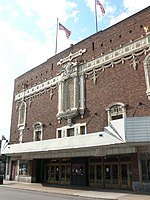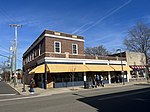2900 Block Grove Avenue Historic District
Historic districts on the National Register of Historic Places in VirginiaHouses in Richmond, VirginiaMission Revival architecture in VirginiaNRHP infobox with nocatNational Register of Historic Places in Richmond, Virginia ... and 3 more
Queen Anne architecture in VirginiaRichmond, Virginia Registered Historic Place stubsUse mdy dates from August 2023

The 2900 Block Grove Avenue Historic District is a national historic district located at Richmond, Virginia. The district encompasses five contributing buildings including three Queen Anne style houses and a square house with Mission/Spanish Revival decorative details. The houses were built between the late-1890s and 1912. Also included is a row of wooden carriage houses with cupolas and gingerbread scroll work.It was added to the National Register of Historic Places in 1973.
Excerpt from the Wikipedia article 2900 Block Grove Avenue Historic District (License: CC BY-SA 3.0, Authors, Images).2900 Block Grove Avenue Historic District
Grove Avenue, Richmond Museum District
Geographical coordinates (GPS) Address Nearby Places Show on map
Geographical coordinates (GPS)
| Latitude | Longitude |
|---|---|
| N 37.555555555556 ° | E -77.476666666667 ° |
Address
Grove Avenue 2911
23221 Richmond, Museum District
Virginia, United States
Open on Google Maps









